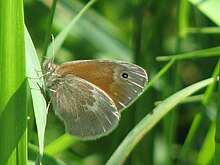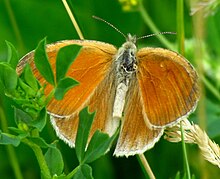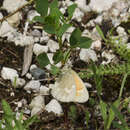Biology
provided by Arkive
The flight period occurs between mid-June and early August. The large heath is single-brooded; eggs are laid singly at the base of the foodplant on dead stems. The larvae hibernate when still small, and emerge in March to complete their development (3). Pupae develop towards the end of April or early May and are attached to stems. Adults emerge around a month later (2).
Conservation
provided by Arkive
Lowland raised bogs and blanket bogs are listed under the EC Habitats Directive, and peatland habitats have been the focus of a number of conservation campaigns. Despite this, peat is still extracted for use in gardens and in horticulture. As large populations of species are more resistant to local extinctions, it is important that large areas of remaining habitats must be conserved and suitable management practices encouraged. Homeowners can help by choosing to use peat-free alternatives in their gardens (3).
Description
provided by Arkive
Adult large heath butterflies always have their wings closed when at rest; males are smoky orange-brown in colour, and females are paler (1). Both sexes have pale brown undersides featuring a creamy white band and a number of eyespots (1). The green caterpillar is around 2.5 centimetres in length and has two white bands along its sides (2).
Habitat
provided by Arkive
Inhabits wet, boggy habitats such as lowland raised bogs, upland blanket bogs and damp acidic moorland where the main foodplant, hare's tail cottongrass (Eriophorum vaginatum) occurs (3). Abundant sources of the most important adult nectar source, cross-leaved heath (Erica tetralix) are also essential (3).
Range
provided by Arkive
Found in Europe, Asia, Canada and western USA, the large heath has undergone serious declines throughout much of Europe. In Britain, it is largely restricted to Scotland and the far north of England with a few small populations persisting in central and eastern England (3) and north Wales (4).
Status
provided by Arkive
Listed on Schedule 5 of the Wildlife and Countryside Act 1981, with respect to sale only (3).
Threats
provided by Arkive
Huge losses of suitable habitat have occurred throughout Europe as a result of large-scale drainage works, commercial forestry plantations and peat extraction. Inappropriate habitat management, such as overgrazing, may be degrading once suitable habitat and causing losses (3).
North American Ecology (US and Canada)
provided by North American Butterfly Knowledge Network
Coenonympha tullia is resident of the northern United States, Alaska, and across most of Canada (Scott 1986). Habitats are prairie, woodland, salt marsh and arctic tundra. Host plants are grasses, including Stipa and Poa pratensis. Individuals overwinter as larvae. There is a variable number of flights based on latitude, with one flight in the northern part of the range and in the Rockies, with approximate flight time July15-Aug. 15 and multiple flights in the southern part of their range, with the approximate flight times Mar. 31-Oct. 31 (Scott 1986).
Conservation Status
provided by University of Alberta Museums
Subspecies benjamini is not of concern. The status of mackenziei is not known.
- license
- cc-by-nc
- copyright
- University of Alberta Museums
Cyclicity
provided by University of Alberta Museums
One flight peaking in June, and at least a partial second brood southward from Aug - Oct.
- license
- cc-by-nc
- copyright
- University of Alberta Museums
Distribution
provided by University of Alberta Museums
As defined here, tullia ranges throughout much of the northern hemisphere, from Scandinavia to AK, south to CA and NM, east to Nfld. (Scott 1986).
- license
- cc-by-nc
- copyright
- University of Alberta Museums
General Description
provided by University of Alberta Museums
"Our smallest satyrine. The unmarked clay-ochre upperside is unique; the underside is tan-grey (ochre forewing base), with a whitish, irregular median line, and often an apical forewing spot, occasionally with remnants of one or two (rarely more) hindwing marginal spots. The ground colour and development of the eyespots is variable. Females are paler overall, and ocasionally have a dark apical forewing spot on the upperside.
Many names have been applied to the western North American ringlets over the years (eg. C. california, inornata and ochracea), a reflection of the fact that it is unclear just how many species are found here, and whether or not any are the same species as the European tullia. There is currently no convincing evidence for any particular interpretation.
Based on differences in ecology and appearance, there appear to be at least two distinct entities in Alberta, one inhabiting far northern boreal fens and grasslands of the Peace-Athabasca delta region (ssp. mackenziei), and the widespread ssp. benjamini."
- license
- cc-by-nc
- copyright
- University of Alberta Museums
Habitat
provided by University of Alberta Museums
Any grassy, open habitats, although absent from much of the boreal forest.
- license
- cc-by-nc
- copyright
- University of Alberta Museums
Life Cycle
provided by University of Alberta Museums
"Although this species is often abundant and can be encountered in most grassy habitats in Alberta, little life history information is available. Hardy's (1960) account of Vancouver Island populations (subspecies insulana, of special conservation concern in BC) is apparently the only one for western Canada: the pale, brown-flecked eggs are barrel shaped, and mature larvae are green with a blue-grey sheen. Larvae have several dorsal and subdorsal dark green lines and a yellow lateral line. The pupa is compact, green and lined with brown, and hangs suspended from grasses.
Ringlet populations in southern Canada are able to complete two generations per year; on southern Vancouver Island, eggs laid by the spring brood either develop to emerge as adults in the summer, or overwinter as mature larvae (Hardy 1960). The can also hibernate as young larvae, offpsring of the second brood. A similar life cycle has been documented in southern Ontario. Only third instar larvae overwinter in northern Ontario, resulting in a single yearly brood (Eberlie 1990).
The distribution and taxonomic status of the taxon mackenziei requires further research before a conservation status assessment can be made; it is currently known only from the Fort Smith region northward along the Mackenzie River to Great Slave Lake."
- license
- cc-by-nc
- copyright
- University of Alberta Museums
Trophic Strategy
provided by University of Alberta Museums
The larval hosts are unconfirmed. Although "grasses" are commonly cited, it is not clear which and how many species are actually suitable. Subspecies mackenziei is associated with sedge fens, so sedges rather than grasses are more likely hosts.
- license
- cc-by-nc
- copyright
- University of Alberta Museums
Coenonympha tullia
provided by wikipedia EN
Coenonympha tullia, the large heath or common ringlet, is a butterfly in the family Nymphalidae.[1][2] It flies in a variety of grassy habitats, including roadsides, woodland edges and clearings, prairies, bogs, and arctic and alpine taiga and tundra.[2] It is a poor flyer, but can sometimes be found along ditches seeking new grounds. It is a holarctic species found in northern Europe, east across the Palearctic and across North America. The species was first described by Otto Friedrich Müller in 1764.[2]
Description in Seitz
C. tiphon Rott. (— davus F., tullia Hbn.) (48h). Upperside sandy yellow, similar to Coenonympha symphita, rather duller; male without markings, female with the ocelli shining through. On the underside of the hindwing whitish smears are joined forming a more or less incomplete median band, beyond which there are some ocelli in the male and often a complete row in the female. In Central Europe, especially in the Alps, Central and Southern Germany and the Danube countries. — philoxenus Esp. (= rothliebi Stgr.) (48 h) is a rather large northern form, dulled with grey above and strongly ocellated below, from the continental shores of the North Sea and Great Britain, (said to have occurred also at Lemberg). — ab. laidion Bkh. is a slight deviation from the type, which is a little paler ochre-yellow on the upperside; it is probably found every-where exceptionally among the nymotypical form. -— isis Tnbg. (= demophile Fr.) (48h) has instead of a brown underside a grey one with fewer and smaller ocelli, and its upperside, which is absolutely without markings, is also of a greyish colour. Scandinavia, North Russia, as far as Central Asia. — viluiensis Mén. (= grisescens Christ.), from the Vilui river in Siberia and from the mountains of Werchojansk, north of Jakutsk, is on both sides bright grey, not yellow; the whitish median band of the underside of the hindwing shines through above and is shaded with grey towards the base; the base of the hindwing beneath washed with green. — caeca Stgr., from the Namangan Mts., is a small form without a trace of ocelli, so that it is superficially similar to pamphilus. — mixturata Alp. is the most eastern form of the Old World, from Kamschatka, and is without ocelli on both sides, like the American ochracea, but instead of being pale yellowish brown, like the latter, is pale grey above; on the underside the hindwing is grey, the forewing ochre yellow with a grey margin. — Across the Behring Sea, in Alaska, the species is represented by the closely allied form kodiak Edw. — The most western old-world form is scotica Stgr., which above has a dull grey ground-colour and dark edges. and beneath is without ocelli; from Ireland and Scotland. — subcaecata Ruhl, from the higher Altai, is an intermediate form, closely allied to ochracea from Colorado; it is darker and larger than caeca, but paler than isis; single specimens show vestiges of ocelli. — rhodopensis Elw. [now Coenonympha rhodopensis Elwes, 1900 ] a form from the Danubian countries, closely allied to isis, but yellowish brown on the upperside and rarely darker in the male.Of the ocelli on the underside only the pupil of the apical one and sometimes of one of the eyes on the hindwing shines through above. But on the underside of the hindwing this form mostly exhibits a complete row of ocelli, while in an otherwise closely related form, occupata Reb., they are entirely absent; the latter form occurs in Bosnia and Herzegovina. — Larva pale green, covered with minute dot-like warts, with a globular green head and yellow mouth, dark light-edged dorsal line, whitish subdorsal lines and pale yellow lateral stripe; anal claspers and anal fork rosy red. From September until May on rushes and reeds, such as Carex, Rhynchospora, Festuca, etc. Pupa pale green, abdomen whitish. — The butterflies are on the wing in June and July, singly, and on most flight-places not common. Sometimes quite fresh specimens are found in places where no single individual had been met with before in spite of decades of ardent collecting, and from where the species again disappeared for a long time. The flight-places are usually peat bogs and meadows flooded from time to time, according to Ruhl especially such on which Eriophorum grows. [3]
Subspecies

Coenonympha tullia var
philoxenus
In alphabetical order:[4][5]
-
C. t. ampelos (W. H. Edwards, 1871) – northwest common ringlet
-
C. t. benjamini (McDunnough, 1928) – prairie ringlet
- C. t. brenda
-
C. t. bosniae (Davenport, 1941)
-
C. t. california (Westwood, 1851) – California ringlet
-
C. t. columbiana (McDunnough, 1928) – ringlet
-
C. t. davus (Fabricius, 1777)
-
C. t. elko (W. H. Edwards, 1881)
-
C. t. elwesi (Davenport, 1941)
-
C. t. eryngii (H. Edwards, 1877)
-
C. t. eunomia (Dornfeld, 1967)
-
C. t. furcae (Barnes & Benjamin, 1926)
- C. t. gliwa
-
C. t. haydenii (W. H. Edwards, 1872) – Hayden's common ringlet
-
C. t. inornata (W. H. Edwards, 1861) – inornate common ringlet
-
C. t. insulanus (McDunnough, 1928) – Vancouver ringlet
-
C. t. kodiak (W. H. Edwards 1869) – Kodiak ringlet
-
C. t. mackenziei (D. Davenport, 1936) – Mackenzie's ringlet
-
C. t. mcisaaci (dos Passos, 1935) – McIsaac's ringlet
-
C. t. mixturata (Alphéraky, 1897)
-
C. t. mono (Burdick, 1942) – (common) ringlet
-
C. t. ochracea (W. H. Edwards, 1861) – ochre (common) ringlet
-
C. t. polydama (Haworth, 1803)
-
C. t. pseudobrenda (Austin & R. Gray, 1998)
-
C. t. scotica (Staudinger, 1901)
-
C. t. sibirica (Davenport, 1941)
-
C. t. subfusca (Barnes & Benjamin, 1926)
-
C. t. suecica (Hemming, 1936)
-
C. t. tullia (Müller, 1764) – common ringlet
-
C. t. viluiensis (Ménétriés, 1859)
-
C. t. yontocket (Porter & Mattoon, 1989) – Yontocket satyr ringlet
-
C. t. yukonensis (W. Holland, 1900) – Yukon common ringlet
Formerly a subspecies:
For more information on subspecies and biology
Etymology
Named in the Classical tradition. The Specific epithet tullia is related to Tullia , daughter of Servius Tullius , sixth Roman emperor, or daughter of Marcus Tullius Cicero , orator, writer and jurist
References
-
^ UK Butterflies
-
^ a b c Common Ringlet Archived 2013-11-20 at the Wayback Machine, Butterflies of Canada
-
^ Seitz. A. in Seitz, A. ed. Band 1: Abt. 1, Die Großschmetterlinge des palaearktischen Faunengebietes, Die palaearktischen Tagfalter, 1909, 379 Seiten, mit 89 kolorierten Tafeln (3470 Figuren)
 This article incorporates text from this source, which is in the public domain.
This article incorporates text from this source, which is in the public domain. -
^ Savela, Markku. "Coenonympha Hübner, [1819]". Lepidoptera and Some Other Life Forms. Retrieved January 14, 2018.
-
^ Coenonympha, Butterflies of America
- Emmet, A.M., J. Heath et al. (Ed.), 1990. The Butterflies of Great Britain and Ireland. The Moths and Butterflies of Great Britain and Ireland Vol. 7 Part 1 (Hesperiidae to Nymphalidae). Harley Books, Colchester, UK. 370p.
- Tomlinson, D. & R. Still, 2002. Britain's Butterflies. WildGuides, Old Basing, UK. 192p.

- license
- cc-by-sa-3.0
- copyright
- Wikipedia authors and editors
Coenonympha tullia: Brief Summary
provided by wikipedia EN
Coenonympha tullia, the large heath or common ringlet, is a butterfly in the family Nymphalidae. It flies in a variety of grassy habitats, including roadsides, woodland edges and clearings, prairies, bogs, and arctic and alpine taiga and tundra. It is a poor flyer, but can sometimes be found along ditches seeking new grounds. It is a holarctic species found in northern Europe, east across the Palearctic and across North America. The species was first described by Otto Friedrich Müller in 1764.

C. t. inornata,
Ottawa,
Ontario, Canada

Dorsal view
- license
- cc-by-sa-3.0
- copyright
- Wikipedia authors and editors


 C. t. inornata, Ottawa, Ontario, Canada
C. t. inornata, Ottawa, Ontario, Canada  Dorsal view
Dorsal view